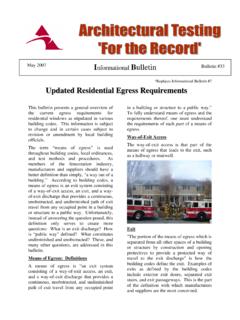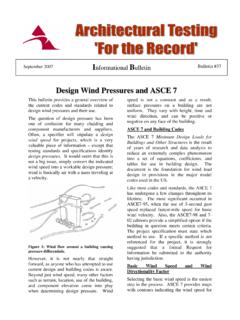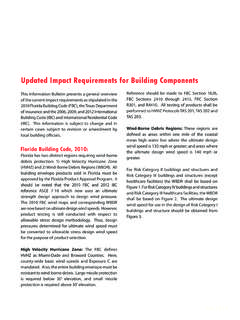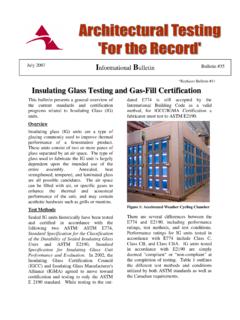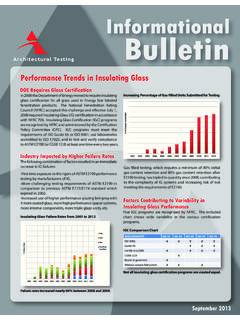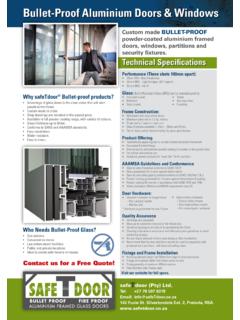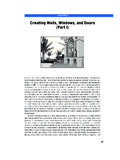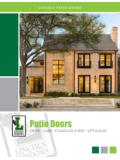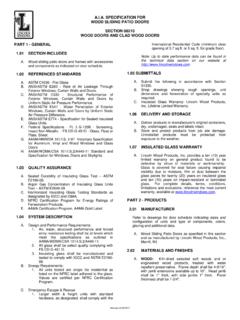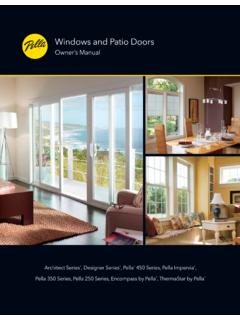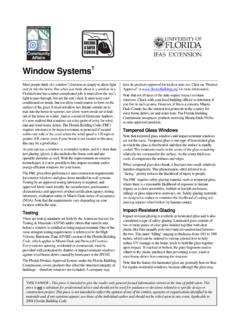Transcription of Building Code Requirements for Windows and Doors
1 Informational Bulletin Bulletin #47 BBuuiillddiinngg CCooddee RReeqquuiirreemmeennttss ffoorr WWiinnddoowwss aanndd DDoooorrss This Informational Bulletin provides a summary of Building codes that are current for Windows and Doors . It is important to understand that local and state adoption of the current codes are dependent on review cycles and not all states and local jurisdictions have adopted the most recent versions of the codes cited.
2 In any case it is important to be aware of the updated code Requirements in this very competitive environment. Scope of Summary The codes are categorized into two broad groups - Residential and Commercial: Residential: 2003 International Residential Code for One- and Two-Family Dwellings. International Code Council 2003. 2006 International Residential Code for One- and Two-Family Dwellings. International Code Council 2006. 2007 Florida Building Code, Residential.
3 International Code Council, 2008. Safer Living Builder s Guide, 2008 Edition. IBHS, 2007. Commercial: 2003 International Building Code. International Code Council, 2003. 2006 International Building Code. International Code Council, 2006. Florida Building Code, Building . International Code Council, 2008. Informational Bulletin Bulletin #47 Building Code Requirements for Windows and Doors Page 2 of 4 Building Code Requirements (AWS) The current Building codes require that Windows and Doors be tested and labeled for air infiltration, water penetration resistance and structural performance (AWS) in accordance to a particular version of an AAMA/WDMA/CSA standard specification.
4 There have been many changes over the years to both the codes and standard specifications, therefore the applicable code will reference a specific version of the specification. Air/water/structural testing is required for all fenestration products, whether they 9 for products that are not intended for use in wind-borne debris regions; 9 for products intended for use in wind-borne debris regions, but protected by an approved protection device; or 9 for impact-resistant products intended for use in wind-borne debris regions.
5 The 2003 version of the I codes require that Windows and Doors be tested to AAMA/NWDA 101 The 2006 version of the codes require that Windows and Doors be tested to AAMA/WDMA/CSA 101 There are a few special cases to be aware of as it relates to specific state Requirements . The special cases include the Texas Department of Insurance which requires that Windows be tested to AAMA/WDMA/CSA 101 , and the Florida codes which allow for either the 97 or 05 version of the standards as well as TAS-202.
6 All of the International Codes and the Texas Department of Insurance require independent certification and labeling for approval. The 2007 Florida codes require DCA product approval. Additionally, for areas in High Velocity Hurricane Zones (HVHZ), products must comply with the TAS protocols. Building Code Requirements (Impact) In addition to AWS testing, Windows used in wind-borne debris regions are required to protect against wind-borne debris.
7 While certification and labeling are not a requirement in all cases, the specific Requirements cited are as follows: The 2003 version of the codes require that Windows and Doors be tested to ASTM E 1996-01. The 2006 version of the codes require that Windows and Doors be tested and labeled to ASTM E 1996-04 or AAMA 506-00, which in turn requires testing to ASTM E 1996-04. The special cases again are the Texas Department of Insurance which requires that Windows and Doors be tested and labeled to AAMA 506-06, which requires testing to ASTM E 1996-02 or ASTM E 1996-05.
8 The 2007 Florida codes require testing to ASTM E 1996-02 or 05, or to the AAMA 506-06, while locations in HVHZ must be tested to the TAS-201/TAS-202 protocols. Fortified Housing (Fortified Program) The Fortified program, specifies design, construction and product approval guidelines to increase a new home's resistance to natural, catastrophe-level perils such as high wind and hurricane. It is not a Building code, but an insurance industry incentive program that can lead to lower insurance rates for the homeowner.
9 As it relates to Windows , the approach is to specify a higher basic wind speed than required by code and then select products that meet the associated wind pressure and Informational Bulletin Bulletin #47 Building Code Requirements for Windows and Doors Page 3 of 4 wind-borne debris Requirements . In summary the Requirements are: using the ASCE 7 design wind speed for the site, plus an additional 20 MPH, and components and cladding loads are to be determined based on an Exposure C, regardless of the actual Building exposure.
10 Two other notes of importance for the Fortified program are 9 Windows installed in wind-borne debris regions may be non-impact Windows , provided that they are protected by an approved protection device, and 9 the Fortified program has additional special Requirements for window installations, relating primarily to flashing and water infiltration. Energy Codes Energy performance is mandated by the International Energy Conservation Code (IECC).


